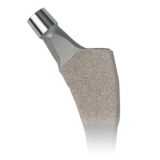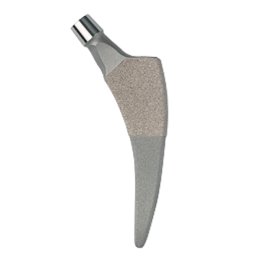Ürün Açıklaması
Ve birden aileleri Fitmore Kalça Kök küçük kesiler kolaylaştıran bir implant tercih cerrahlar için bir kemik koruyucu, eğri kök geometri ile kişiselleştirilmiş bir uyum sunuyor. Sistemi farklı medial eğrilikleri ile ofset eşleşen kök yenilikçi konsepti ile her bireyin anatomi istikrarlı yeniden sağlamayı amaçlamaktadır. Trapez kesitli rotasyonel stabilite için sağlarken üçlü konik tasarım ve proksimal Ti-Plazma kaplama, press-fit güvenli kılar.
Fitmore sistemi uzun bir ofset seçeneği mevcuttur Aile B ile üç farklı ailesi oluşur. Ailelere baş merkezi ve femoral kanal medial eğriliği arasındaki ilişkiyi ele almak geliştirilmiştir. Her kök ailesi medial kontur, boyun şaft açısı ve kök uzaklıklar aralığı bakımından farklıdır.
Kemik korunması total kalça artroplastisi önemli bir yönüdür. Bir primer operasyon sırasında mümkün olduğunca az kemik gibi kaldırarak, cerrah olası gelecekteki revizyon cerrahisi için daha fazla seçenek bırakıyor. Fitmore Hip kısa kavisli kök tasarım kemiğin korunmasına yardımcı olur.
Fitmore Hip Kök kısa uzunluğu ve kavisli tasarımı konularda en büyük trokanter, hastanın doğal kemik korunmasına yardımcı olur.
Zimmer total kalça artroplastisi için daha az invazif yaklaşımların ön planda olmuştur. Lideri olarak Minimal İnvaziv Çözümleri ™ prosedürleri, Zimmer sunmaktan gurur duyar Fitmore Hip Stem, zihin kas ve yumuşak doku koruyucu yaklaşımlar ile tasarlanmış bir implant.
Fitmore raspalar ve implantlar kalkarda kemer boyunca eğri atravmatik yörünge ve takılmasını sağlamak. Bu eğimli giriş yoluyla, potansiyel olarak kalça kaçıran ekleme noktası koruyucu, yanal trokanter açmak için herhangi bir gerek yoktur.
Ürün Broşürü

Indications
This femoral stem is for total or hemi hip arthroplasty and is indicated for the following conditions: Patient conditions of noninflammatory degenerative joint disease (NIDJD), e.g., avascular necrosis, osteoarthritis and inflammatory degenerative joint disease (IJD), e.g., rheumatoid arthritis; those patients with failed previous surgery where pain, deformity, or dysfunction persists; revision of previously failed hip arthroplasty.
Total hip replacements may be considered for younger patients if any unequivocal indiction outweighs the risks associated with the age of the patient and modified demands regarding activity and hip joint loading are assured. This includes severely crippled patients with multiple joint involvement, for whom an immediate need of hip mobility leads to an expectation of significant improvement in the quality of their lives.
This stem is for uncemented use.
Contraindications
Patient's physical conditions that would eliminate or tend to eliminate adequate implant support or prevent the use of an appropriately sized implant, e.g., previous surgery, insufficient quality or quantity of bone resulting from conditions such as cancer or congenital dislocation, metabolic bone disease of the upper femur or pelvis, femoral osteotomy revision, girdlestone revision, osteoporosis, osteomyelitis, neuromuscular compromise or vascular deficiency in the affected limb in sufficient degree to render the procedure unjustifiable (e.g., absence of musculoligamentous supporting structures, joint neuropathy) or other conditions that may lead to inadequate skeletal fixation.
Active infection of the hip, old or remote infection. This may be an absolute or relative contraindication. Every effort should be undertaken to rule out preoperative infection in a patient with suspicious symptoms, such as a history of, or when there are signs of, local inflammation, abscesses, fever, increased blood sedimentation rate, evidence of rapid joint destruction or bone resorption.
Allergy to the implanted material, above all to metal (e.g. cobalt, chromium, nickel, etc.)
Local bone tumors and/or cysts.
Pregnancy.







